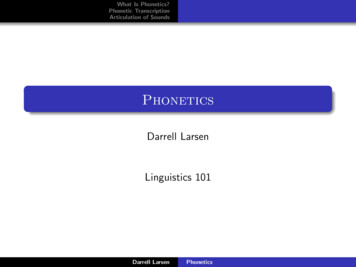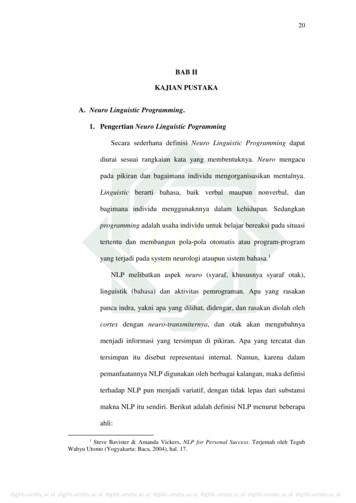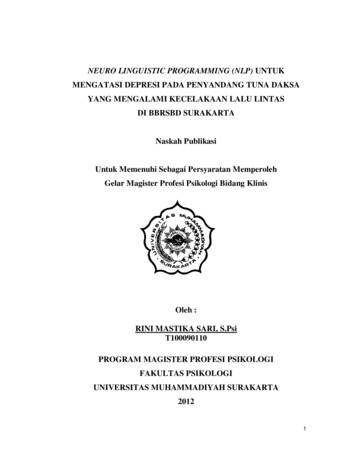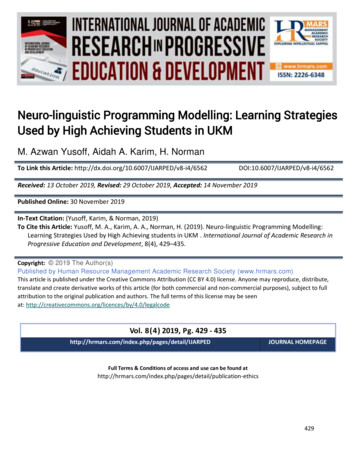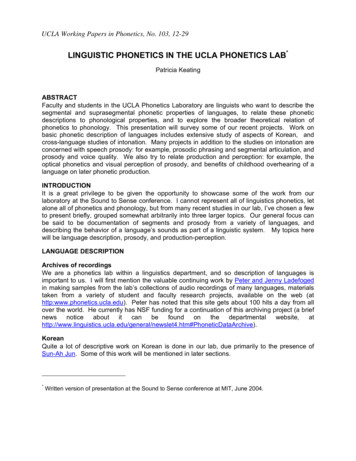
Transcription
UCLA Working Papers in Phonetics, No. 103, 12-29LINGUISTIC PHONETICS IN THE UCLA PHONETICS LAB*Patricia KeatingABSTRACTFaculty and students in the UCLA Phonetics Laboratory are linguists who want to describe thesegmental and suprasegmental phonetic properties of languages, to relate these phoneticdescriptions to phonological properties, and to explore the broader theoretical relation ofphonetics to phonology. This presentation will survey some of our recent projects. Work onbasic phonetic description of languages includes extensive study of aspects of Korean, andcross-language studies of intonation. Many projects in addition to the studies on intonation areconcerned with speech prosody: for example, prosodic phrasing and segmental articulation, andprosody and voice quality. We also try to relate production and perception: for example, theoptical phonetics and visual perception of prosody, and benefits of childhood overhearing of alanguage on later phonetic production.INTRODUCTIONIt is a great privilege to be given the opportunity to showcase some of the work from ourlaboratory at the Sound to Sense conference. I cannot represent all of linguistics phonetics, letalone all of phonetics and phonology, but from many recent studies in our lab, I’ve chosen a fewto present briefly, grouped somewhat arbitrarily into three larger topics. Our general focus canbe said to be documentation of segments and prosody from a variety of languages, anddescribing the behavior of a language’s sounds as part of a linguistic system. My topics herewill be language description, prosody, and production-perception.LANGUAGE DESCRIPTIONArchives of recordingsWe are a phonetics lab within a linguistics department, and so description of languages isimportant to us. I will first mention the valuable continuing work by Peter and Jenny Ladefogedin making samples from the lab’s collections of audio recordings of many languages, materialstaken from a variety of student and faculty research projects, available on the web (athttp:www.phonetics.ucla.edu). Peter has noted that this site gets about 100 hits a day from allover the world. He currently has NSF funding for a continuation of this archiving project (a briefnewsnoticeabout it can rchive).KoreanQuite a lot of descriptive work on Korean is done in our lab, due primarily to the presence ofSun-Ah Jun. Some of this work will be mentioned in later sections.*Written version of presentation at the Sound to Sense conference at MIT, June 2004.
IntonationAlso due to Sun-Ah Jun, work on intonation, especially ToBI-style analysis of intonation, is afocus in the lab. The name ToBI stands for tones and break indices, referring to the two kinds ofelements in this system of analysis. It’s worth noting that the first ToBI system, for AmericanEnglish (Silverman et al., 1992), was developed in part at MIT due to the efforts of severalpeople attending the Sound To Sense conference, and that the prior work that informed thesubstance of ToBI systems also originated at MIT – the tone part of ToBI from JanetPierrehumbert’s Linguistics dissertation (Pierrehumbert, 1980), and the break index part in theSpeech Group (e.g. Price et al., 1991). An edited book that is about to appear, ProsodicTypology: The Phonology of Intonation and Phrasing (Jun, 2004), presents and compares ToBIanalyses of 14 languages (see http://www.oup.co.uk/isbn/0-19-924963-6). Several languageshave been described at UCLA, including Seoul, Chonnam, and Kyungsang Korean, French,Greek, Argentinian Spanish, and Farsi. In addition to language description, studies of intonationalso treat its applications to clinical populations, to sentence processing, and to secondlanguage learning. These are growing research areas in the field and in our lab.PhonationAnother kind of language description concerns phonation, specifically the phonetic correlates ofphonologically contrastive phonation types (voice qualities) in languages: voice qualities such asmodal, breathy, and creaky, as in the Zapotec languages of Oaxaca, Mexico. Work on nonmodal phonation in our lab goes back to Peter Ladefoged and Ian Maddieson, and is an interestwe share with the voice laboratory in the UCLA medical school. Our quantitative study of voicewas jump-started by Peter’s visit some 20-plus years ago to the MIT Speech Group, where helearned about a new acoustic measure of phonation type, H1-H2.First, examples from a language in which isolation forms show the phonation contrast quite well:San Lucas Quiavini Zapotec, in Figure 1. These are three words that differ in their phonation,as part of the phonology of the language. (To hear these examples, please go to slide 5 in theoriginal Powerpoint presentation available on-line.)Next, Figure 2 gives examples from the Zapotec language (Santa Ana del Valle Zapotec) thatChristina Esposito is studying. (To hear these examples, please go to slide 6 in the Powerpointpresentation.) The figure also gives averages of an acoustic measure (H1-A3, due to Klatt) fora corpus of words for one of her three speakers, from Esposito (2003a, 2003b). The acousticmeasure shows, as expected, that in breathy voice the fundamental dominates over the higherfrequencies, while in creaky voice the higher frequencies are stronger.Now at first it was not entirely clear that this language really had these contrasts, and it turns outthat there was an interesting reason for that confusion. Figure 3 shows the same acousticmeasure for the same items as in the previous figure, but now divided out by different ranges offundamental frequency. The contrast is clear only at lower f0s, as on the right of Figure 3; whenf0 is high, as on the left, the contrasts are almost merged and are very hard to hear. And in thislanguage, isolation or citation forms, like focused forms in initial position in sentences, have ahigh f0. So just in the kinds of forms a fieldworker might elicit, the contrast is not apparent, andknowledge of the intonational system is crucial to understanding the phonation system. Thisobservation leads to our next major topic.13
Figure 1. Spectrograms and waveforms of three words of San Lucas QuiaviniZapotec contrasting in phonation type. The circles point out the regions of nonmodal phonation. Prepared by Melissa Epstein using recordings made byMatthew Gordon of UC Santa Barbara.Figure 2. Mean spectral tilt measure (amplitude of the fundamental minus theamplitude of the highest harmonic in the third formant) for three phonation typesproduced by a male speaker of Santa Ana del Valle Zapotec, and example of aminimal triplet. Prepared by Christina Esposito.14
Figure 3. Same data as in Figure 2, but divided by fundamental frequency range,which varies with position in utterance. Prepared by Christina Esposito.PROSODYBy prosody I mean the organization of speech into a hierarchy of units or domains (the groupingfunction of prosody) in which some units are more prominent than others (the prominencemarking function of prosody, where prominence includes what is called accent, or phrasalstress).Prosody and voice qualityIntonation is part of prosody, and we have already seen an effect of intonational f0 on phonationcontrast in Santa Ana del Valle Zapotec. Another effect of prosody on voice quality, related tointerests in the MIT speech group, is non-contrastive phonation varying with intonation. That is,even in a language like English, non-modal phonations (breathy, creaky) occur, but governed byprosody rather than the lexicon. Furthermore, there is also phonation variation within modalvoice quality (laxer, tenser phonation), similarly governed by prosody. Both of these kinds ofvoice quality variation as a function of position and accent have been studied by MelissaEpstein (2002, 2003).Consider first the occurrence of non-modal phonation at different locations in English sentences.Non-modal phonation was defined as glottal cycles which could not be fit with the LF model(Fant et al., 1985). Figure 4 gives Epstein’s finding for three speakers: phrase-final Lowboundary tones have more non-modal phonation than High tones. That is not a surprisingresult, but perhaps surprising is that it is the phonological Low tone, that is, a phrase-final low f0,not the low f0 per se, that matters. The evidence that low f0 is not itself the determining factor,seen in Figure 5, is that Low tones associated with accent are generally modal, even with a lowf0. It it unaccented words, not accented words, that have more non-modal phonation. So, thephonation variation is linked to the phonological system of prosody, not just to f0.15
Figure 4. Percent of test syllables with non-modal phonation for Low vs. Highboundary tones, for three speakers of American English in Epstein’s study.Figure 5. Percent of syllables with non-modal phonation when pitch-accented vs.unaccented, for three speakers of American English in Epstein’s study.Figure 6. Mean values of Excitation Energy, normalized for each speaker, forprominent (accented) vs. non-prominent syllables. Higher value indicates tenserphonation. Prepared by Melissa Epstein.16
With respect to variation within modal phonation, Epstein found the values of the parameters ofthe LF model for individual glottal cycles, normalized for each speaker relative to a baselinevalue. She compared these values for prominent vs. non-prominent words, and for phraseinitial prominent vs. phrase-final prominent words. The result, shown in Figure 6 for the LFmodel parameter Excitation Energy, was that prominent words have a tenser voice quality.Further analysis showed that this held especially for phrase-initial prominent words.Phrasing and articulationProsody does not affect only phonation; a major focus in our lab is its effect on segmentalproperties. That is, how each segment’s phonological properties are realized phoneticallydepends in part on the segment’s position in prosodic structure. An idea from traditionalhistorical phonetics concerned with understanding historical sound changes is strengthening,that is, the idea that some positions are stronger than others, and segments in those positionsare stronger. That is they show articulatory strengthening, or more extreme articulations. Now,it seems that these stronger positions can be derived from a prosodic hierarchy; for example,initial in a prosodic domain is a strong position. The prosodic hierarchy is a proposal fromphonology that has turned out to have important consequences for phonetics. (See ShattuckHufnagel & Turk, 1996 for a review.) Here in Figure 7 is part of a prosodic hierarchy, whichshows smaller units grouped into larger ones, or, viewed from the top down, how a larger unitlike the Utterance is composed of one or more Intonational Phrases. Our interest is thearticulation of segments that are in stronger positions within such a structure. The beginning ofa major phrase, for example, is a stronger position than the beginning of a word inside a phrase.We have mostly looked at articulatory strengthening using electropalatography; for example,comparing maximum total tongue-palate contact of segments across prosodic positions, e.g. indifferent initial positions. We have studied four languages: English (e.g. Fougeron & Keating1997), Korean (Cho & Keating 2001; Kim 2001, 2003), French (Fougeron 1998, 2001), andTaiwanese (Keating et al. 2003). Electropalatography uses an acrylic false palate embeddedwith small contact electrodes (Figure 8); when the tongue touches the pseudo-palate, thecontact pattern is recorded to a computer.higherlowerUUtteranceIntonational PhraseIPSmaller PhraseXPWordWSyllableIPXPW. s sXPWsWWs .Figure 7. Partial prosodic hierarchy (some domains omitted), from Keating et al.(2003). The smaller phrase is labeled XP because it varies across languages.From Keating et al. (2003).17
Figure 8. Custom electrode layout on the pseudo-palate for the Kay ElemetricsPalatometer. The 96 gold electrodes are the dots seen on the palate.Figure 9 is a sample frame of contact, for an /n/; it shows tongue contact all around the edge ofthe palate, especially the sides of the tongue with the inner surfaces of the teeth. Figure 10presents a set of such frames, showing the maximum contact for French /n/s taken from thebeginnings of five successively smaller prosodic domains, with less contact in the weakerpositions. (To hear two of these examples, please go to slide 19 in the Powerpointpresentation.)Figure 9. Sample frame of contact, for Korean word-initial /n/.electrodes, filled ones are contacted.18Circles are
Figure 10. A set of sample data frames of EPG data showing the maximumcontact for French /n/ at the beginnings of five successively smaller prosodicdomains. After Keating et al. (2003).Figure 11 (next page) shows, for Korean, what the overall results from such studies can show :in this case (Cho & Keating 2001), four stops of Korean (tense, aspirated, lax, and nasal) in fourprosodic positions (Utterance-initial, Intonational Phrase-initial, Accentual Phrase-initial, andWord-initial), with less and less total contact for consonants in weaker positions. In contrast tothe overall contact measure shown in Figure 11, Figure 12 gives more detailed measurementsof fricative channels (Kim 2001, 2003); these measurements show another aspect of articulatorystrengthening – more contact can lead to smaller channels in stronger positions.All of these studies show that articulation does indeed vary with prosodic position; this leads to aview of speech production planning which I’ve been thinking about with Stefanie ShattuckHufnagel (Keating & Shattuck-Hufnagel, 2002). In this bigger picture, each phonetic segment,with its features, is a terminal node in a big prosodic tree. Each segment has a position in thetree relative to the domains and prominences of the utterance. Crucially, the pronunciation ofeach feature depends in part on this prosodic position; you don’t know how to pronounce afeature until you know where it is in the tree.To summarize this section of the paper, prosody is a crucial aspect of speech, includingphonation and segmental articulation, and much of our work is organized around understandingthose connections.19
Figure 11. Mean maximum EPG contact for four Korean consonants in fourprosodic positions, averaged for three speakers. Prepared by Taehong Cho.187016Cell Mean f or c hannelCell Mean f or mid65605550451412108642040IPiA PiIPiA Pmmid region contactA PiA Pmchannel region contactFigure 12. EPG contact in two subregions of the palate for Korean /s/ in threeprosodic positions. Prepared by Sahyang Kim.COARTICULATIONMuch of our work in the 1980s on phonetic implementation was concerned with coarticulation,and here are two ways in which it has figured in our more recent work.Initial strengtheningFirst, the relation of coarticulation to domain-initial strengthening has been studied by Cho(2002, 2004). Coarticulation refers to interactions between neighboring segments, generallydue to articulatory overlap; we can ask how prosodic strengthening affects overlap and thuscoarticulation. In particular, does a strong segment resist its neighbors? Cho looked at vowelto-vowel coarticulation between [i] and [a] across [b] and three different prosodic boundaries, asin the set of configurations shown in Figure 13; each vowel was accented, or not. To studytongue position variation, he used electromagnetic articulography, a technique that the MIT20
speech group has done so much to develop (Perkell et al., 1992). At UCLA we use theCarstens Articulograph AG-100, which shares with the MIT system the basic property thatreceiver coils are glued to articulators, and their positions are tracked within an electromagneticfield set up around the head. In Cho’s study the interest was the two coils on the tongue body,T2 and T3 in Figure 14.Figure 13. Design of test sequences in Cho (2002), with two test vowels acrossone of three prosodic boundaries. Prepared by Taehong Cho.Figure 14. Locations of EMA receiver coils, including the two on the tongue bodystudied for vowel articulations, in Cho (2002). Prepared by Taehong Cho.Here we will look at the result for just one case, the effect of V1 [i] on V2 [a]. There is less effectof V1 on V2 across a larger prosodic boundary. Figure 15 shows that [a] is more like [i] whenthey are separated by only a Word boundary, and it is least like [i] when they are separated byan Intonational Phrase boundary.Thus, resistance to coarticulatory influences is anotheraspect of domain-initial strengthening; stronger segments do resist contextual segmentalinfluence.21
Figure 15. Effect of V1 [i] on V2 [a] as a function of prosodic boundary in Cho(2002). Prepared by Taehong Cho.LexiconSeveral studies in the lab have been concerned wtih lexical effects on speech production(Billerey-Mosier 2002, Jones 2002). Rebecca Brown Scarborough has considered lexicaleffects on coarticulation (Brown 2002; Scarborough 2004). The notion of a lexical neighborhood(Luce, 1986, that is, the other words that are similar to a given word, and compete with it, is animportant development in psycholinguistics, and one which affects how a given word ispronounced. Figure 16 is Scarborough’s illustration of two different neighborhoods, one sparseand the other dense.Figure 16. Lexical competitors of a target word (red column) in a sparseneighborhood (left) vs. in a dense neighborhood (right). Bar height indicatesfrequency of occurrence; absolute frequency of the target word (the red bars) isthe same in the two cases. Prepared by Rebecca Scarborough.22
The question of interest here is: Are words from dense lexical neighborhoods, with many lexicalcompetitors, produced with more or less coarticulation than other words? Scarborough (2004)has looked at production of two kinds of coarticulation in two directions, but here I present anearlier partial result, for nasal coarticulation in CVN words (Brown 2002). She compared thenasalization of vowels before nasal consonants in words from sparse (“easy”) vs. dense (“hard”)neighborhoods. Some sample words from the corpus are given in Table 1. The acousticmeasure of nasalization she used, A1-P0, is one developed in the MIT Speech Group (Chen1996). The result, shown in Figure 17, was more nasal coarticulation in “hard” words. That is,just as phonetic details are modulated by prosody, so too are they modulated by a word’s lexicalstatus.Table 1. Sample words in the CVN corpus. Easy words have fewer/less frequentcompetitors; hard words have more/more frequent competitors, as in Figure 16.HARDEASYbunspongefenddrumgumblondeFigure 17. Amount of nasalization in the vowels of hard vs. easy CVN words.Prepared by Rebecca Scarborough.PRODUCTION AND PERCEPTIONFinally, I will present some of our work on perception as it relates to production.Optical prosodyOur work on optical phonetics has been part of a project with UCLA Electrical Engineering andthe House Ear Institute. One of our questions has been what aspects of production are23
important to visual perceivers, including with respect to prosody. Consider the optical signalavailable for the visual perception of phrasal stress-accent: the extents, durations, and velocitiesof movements of the lips, chin, head, and eyebrows are all potentially visible. Thus in aproduction-perception comparison, we can ask which of the optical correlates of stress-accentaccount for its visual intelligibility, to the extent that it is indeed intelligible.Our study (Keating et al., 2003 and in preparation) first looked at the production of stress-accentby three speakers. Table 2 illustrates the kind of utterance studied, andwhat is meant by phrasalstress-accent here. Each sentence contained three proper names, one of which could bestressed. The three speakers read these sentences while being videotaped, and while themovements of 20 reflectors attached to the face were tracked. A sample frame of video,showing the locations of the reflectors, is shown in Figure 18; these markers were tracked byinfrared cameras. The 11 measurements listed in Figure 18 were made from the indicatedsubset of the markers. (For more details about the methods in this and related studies in theproject, see Jiang et al., 2002.)Table 2. Sample sentences in the phrasal stress-accent corpus. Underlinedwords are test words; speakers were instructed to accent words in all-caps.So TOMMY gave Timmy a song from Debby.So Tommy gave TIMMY a song from Debby.So Tommy gave Timmy a song from DEBBY.So Tommy gave Timmy a song from Debby.Figure 18. Sample video frame showing facepoint marker locations.24
Table 3. Measurements taken from facial markers.Left eyebrow displacementHead displacementInterlip maximum distanceInterlip opening displacementInterlip closing displacementLower lip opening peak velocityLower lip closing peak velocityChin opening displacementChin opening peak velocityChin closing displacementChin closing peak velocityFigure 19. Sample correlate of phrasal stress: chin closing peak velocity forstress-accented vs unaccented syllables in three positions in test sentences.This production study showed that all 11 measuresvaried depending on the phrasal stressaccent. For example, Figure 19 shows the differences in maximum closing velocity of the chinmarker, for accented vs. unaccented vowels in names in all three positions: the chin rises morequickly in a stress-accented vowel. The chin and eyebrow measures were affected by stressaccent most consistently across speakers.We then looked at the perception of these phrasal stress-accents. We took videos of sentencesfrom the production study, and played them, without sound, to perceivers. They saw, along with25
the video clip, a written sentence, and their task was to indicate which name in the sentence, ifany, had received a stress. Figure 20 shows the results. All three speakers were intelligibleabove chance, and all 16 perceivers performed above chance. But crucially, performance wasfar from perfect, which allows us to examine what aspects of the signal, of the 11 potentiallyavailable cues that we have identified, the perceivers seem to be using.Figure 20. Percent correct visual perception of phrasal stress, by talker (3) andby perceiver (16). Chance is 50 percent.Correlation analysis, and partial correlations, show that the chin opening measures (chinopening displacement and peak velocity) are most related to visual perception performance.These production measures account for the most variance in perception. Other measures, suchas chin closing measures, lip measures, head movements, or eyebrow movements, are not aswell correlated, even though we know that some of them vary as much in production. This kindof study tells us which aspects of the optical speech signal seem to be most informative toperceivers, and this kind of information could be useful for face synthesis applications.Heritage language abilityFinally, a rather different topic concerns the relation of production and perception abilities withinindividuals, from work by Sun-Ah Jun and Terry Au with students, e.g. Oh et al. (2003). Acommon linguistic background in cities like Los Angeles is that of children who give up theirheritage language in favor of English. Their project included a study of adults learning Koreanin college classes; they compared four groups of adults: a control group of lifelong nativespeakers, a group who spoke only in early childhood no later than age 7, a group who overheadbut did not speak, and a control group with no childhood exposure to the language. Here I givetheir results on these adults’ production of VOT in Korean denti-alveolar stops. As seen inFigure 21, the childhood-only speakers were essentially like the native speakers, while thechildhood overhearers were essentially like the no-Korean group. The same result held ofoverall foreign accent ratings for the speakers. That is, if you spoke Korean for even a while as26
a child, you will have good pronunciation as an adult, but if you did not speak it as a child,merely having overheard it is no immediate help in your later pronunciation.Figure 21. Mean production of VOT for Korean denti-alveolar stops, by lifelongnative speakers, childhood-only speakers, overhearers, and never-exposedspeakers.However, looking at adult perception of Korean VOT, as seen in Figure 22 (next page), againthe childhood-only speakers were as good as native speakers, but the childhood overhearerswere also as good as native speakers. That is, even just overhearing from childhood is enoughto give a later perceptual advantage, without any speaking experience. Furthermore, in aparallel Spanish study that also looked at later performance in a language classroom (Knightlyet al., 2003), they found that childhood overhearing without speaking does give an advantage inlater learning of pronunciation. In the long run, the project should help us to understand whatadvantages may remain in later life from early exposure to a heritage language.CONCLUSIONIn this paper I have tried to give a taste of what some linguistic phoneticians in the UCLAPhonetics Lab are interested in today. We invite you to visit our lab’s website, which hasinformation about other projects as well. We believe that a linguistic phonetics program,especially one with outstanding colleagues in phonology, as at UCLA, is a great place to beinterested in speech.27
Figure 22. Percent correct perception of VOT for Korean stops, by same fourgroups of speakers as in Figure 21.REFERENCESBillerey-Mosier, R. (2002) Lexical effects on the phonetic realization of English segments, UCLAWorking Papers in Phonetics, 100, 1-32.Brown, R (2001) Effects of lexical confusability on the production of coarticulation, UCLAmasters thesis. Also available in UCLA Working Papers in Phonetics, 101, 1-34 (2002).Chen, M (1996) Acoustic Correlates of Nasality in Speech, MIT Ph.D. dissertation.Cho, T. (2002) The Effects of Prosody on Articulation in English, New York: Routledge.Cho, T. (2004) Prosodically-conditioned strengthening and vowel-to-vowel coarticulation inEnglish, Journal of Phonetics, 32, 141-176.Cho, T. & Keating, P. (2001) Articulatory and acoustic studies on domain-initial strengthening inKorean, Journal of Phonetics, 29, 155-190.Epstein, M. (2002) Voice Quality and Prosody in English, UCLA Ph.D. dissertation.Epstein, M. (2003) Voice quality and prosody in English, Proc. XVth International Congress ofPhonetic Sciences, Barcelona, 2405-2408.Esposito, C. (2003a) Phonation in Santa Ana del Valle Zapotec, UCLA masters thesis. Also toappear in UCLA Working Papers in Phonetics, 103 (2004).Esposito, C. (2003b) The effects of f0 and position-in-utterance on phonation in Santa Ana delValle Zapotec, Proc. XVth International Congress of Phonetic Sciences, Barcelona.Fant, G., Liljencrants, J. & Lin, Q. (1985) A four-parameter model of glottal flow, Paperpresented at the French-Swedish Symposium, Grenoble, France.Fougeron, C. (1998) Variations articulatoires en début de constituants prosodiques de différentsniveaux en français, Université Paris III-Sorbonne Nouvelle Ph.D. dissertation.Fougeron, C. (2001) Articulatory properties of initial segments in several prosodic constituentsin French, Journal of Phonetics, 26, 45-69.Fougeron, C. & Keating, P. (1997) Articulatory strengthening at edges of prosodic domains,Journal of the Acoustical Society of America, 101, 3728-3740.Jiang, J., Alwan, A., Bernstein, L. E., Keating, P. & Auer, E. T. (2002) On the correlationbetween face movements, tongue movements, and speech acoustics, EURASIP Journal onApplied Signal Processing. Special Issue on Joint Audio-Visual Speech Processing, 11.28
Jones, A. (2002) A lexicon-independent phonological well-formedness effect: Listeners’sensitivity to inappropriate aspiration in initial /st/ clusters, UCLA Working Papers inPhonetics, 100, 33-72.Jun, S.-A. (ed.) (2004) Prosodic Typology: The Phonology of Intonation and Phrasing, OxfordUniversity Press.Keating, P., Cho, T., Fougeron, C. & Hsu, C.-S. (2003) Domain-initial articulatory strengtheningin four languages, In Phonetic Interpretation (Papers in Laboratory Phonology 6) (edited byJ. Local, R. Ogden and R. Temple), Cambridge University Press, 143-161.Keating, P., Baroni, M., Mattys, S., Scarborough, R., Alwan, A., Auer, E. & Bernstein, L. (2003)Optical phonetics and visual perception of lexical and phrasal stress in English, Proc. XVthInternational Congress of Phonetic Sciences, Barcelona, 2071-2074Keating, P. & Shattuck-Hufnagel, S. (2002) A prosodic view of word form encoding for speechproduction, UCLA Working Papers in Phonetics, 101, 112-156.Kim, S. (2001) The interaction between prosodic domain and segmental properties: domaininitial strengthening of Korean fricatives and Korean post obstruent tensing rule, UCLAmasters thesis.Kim, S. (2003) Domain initial strengthening of Korean fricatives, In Harvard Studies in KoreanLinguistics IX (edited by S. Kuno et al. ), Seoul, Korea: Hanshin Publishing Company.Luce, P. A. (1986) Neighborhoods of words in the mental lexicon, Research on SpeechPerception Progress Report, No. 6, Indiana University Psychology Department, SpeechResearch Laboratory.Oh, J.S., Jun, S.-A., Knightly, L. M. & Au, T. K.-F. (2003) Holding on to childhood languagememory, Cognition, 86, 53-64.Knightly, L. M., Jun, S.-A., Oh, J.S. & Au, T. K.-F. (2003) Production benefits of childhoodoverhearing, Journal of the Acoustical Society of America, 114, 465-474.Perkell, J.S., Cohen, M., Svirsky, M., Matthies, M., Garabieta, I. & Jackson, M. (1992) Electromagnetic midsagittal articulometer (EMMA) systems for transducing speech articulatorymovements, Journal of the Acoustical Society of America, 92, 3078-3096.Pierrehumbert, J. B. (1980) The Phonology and Phonetics of English Intonation, MIT Ph.D.dissertation.Price, P.J., Ostendorf, M
a major phrase, for example, is a stronger position than the beginning of a word inside a phrase. We have mostly looked at articulatory strengthening using electropalatography; for example, comparing maximum total tongue-palate contact of segments across prosodic positions, e.g. in


